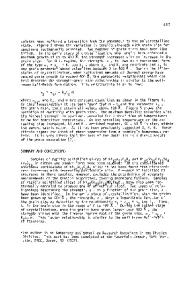Microstructural evolution in rapidly solidified Al-Fe alloys: An alternative explanation
- PDF / 2,960,326 Bytes
- 8 Pages / 597 x 774 pts Page_size
- 101 Downloads / 334 Views
I.
INTRODUCTION
B I N A R Y , ternary, and quaternary alloy systems based on the AI-Fe system have been the subject of much study in the past two decades, particularly in the last 5 to 10 years. [1-6] The primary focus of these studies has been to develop an aluminum alloy system with a higher temperature capability than conventional A1 alloys for use in particular aerospace structures. A1-Fe is an attractive system due to the extent to which its microstructure can be altered by rapid solidification processing (RSP). In particular, the production of fine dispersoids that exhibit unusually low coarsening rates forms the basis for most of the high-temperature aluminum alloys developed to date. However, because of the extreme complexity of these microstructures, interpretations of the sequence of solidification events that lead to such structures have varied considerably. One aspect of these microstructures that is quite unusual is the formation of randomly oriented intercellular intermetallic dispersoids with diameters on the order of 50 nm in a microcellular matrix. This is based on the fact that in typical cellular or microcellular microstructures, the intercellular phase forms as a result of solute rejection from the adjacent cells; this causes the intercellular regions to reach a composition and temperature where formation of a second phase ensues with an orientation relationship that minimizes the local interfacial energies. In contrast, an orientation relationship between a primary intermetallic compound and the matrix is not expected. In order to explain the deviation of the AI-Fe system from typical microcellular solidification behavior at large undercoolings, it has been suggested that the randomness of orientation stems from the initial formation of amorphous intercellular regions which subsequently crystallize as the temperature of the regions increases due to recalescence; this would result in randomly oriented particles in the intercellular regions, iT,s1 A problem with this scenario concerns the fact that these intercellular re-
J.D. COTTON, Graduate Student, and M.J. KAUFMAN, Associate Professor, are with the Department of Materials Science and Engineering, University of Florida, Gainesville, FL 32611. Manuscript submitted January 16, 1990.
METALLURGICAL TRANSACTIONS A
gions must form after the primary aluminum cells and, consequently, after the release of the latent heat of fusion. Even if such an argument were correct, it should be possible to suppress the "crystallization" of this phase and retain the amorphous structure by simply increasing the quench rate of the RSP process--to our knowledge, this has not been achieved to date. Finally, the dispersoid size appears to be more or less constant and independent of the scale of the A1 cells; again, this is inconsistent with typical cellular solidification structures where the size of the intercellular phase(s) scales with the cell size and spacing. Another unusual characteristic of these alloys, as stated above, is the low coarsening rates of the
Data Loading...











